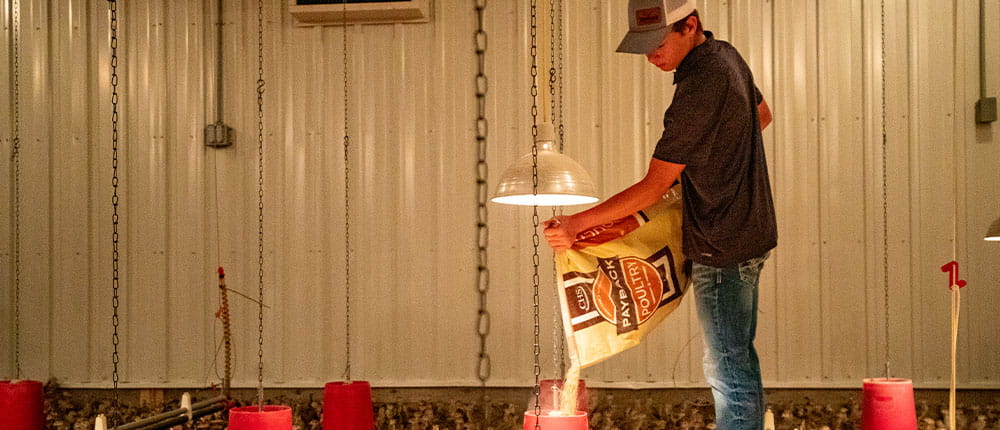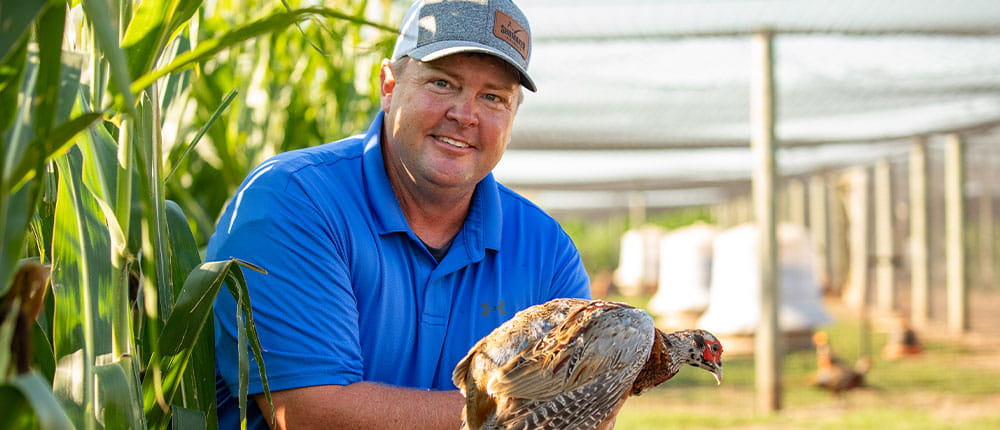When leaves start changing color and the air is crisp, families and friends gather across the central United States for one of their favorite fall pastimes: pheasant hunting. Many of those birds are raised by pheasant growers like Adam and Stacey Shumaker.
The Shumakers raise pheasants in Howard, S.D. South Dakota is considered by many to be the pheasant capital of the world. Every year, more than 100,000 licenses are issued in the state, many to out-of-state visitors.
Shumaker’s dad, Dale, started Top Gun Pheasant Hunting Lodge in 1991. The family raised 300 to 500 pheasants for the lodge. Adam’s brother, Kevin, now runs Top Gun. After Adam and Stacey married in 2001, they decided to raise pheasants on their own.
“Within a couple of months of getting married, we moved to Howard to a pasture in a cornfield,” Shumaker says. They built a house and barn in that pasture and their dream quickly became reality — Shumaker Ringnecks was in business.
“We just kind of fell from the sky and raised 20,000 birds that first year,” Shumaker says. “I had a lot of people tell me we wouldn’t make it, but I just kept my head down and made it happen.”
Adam, Stacey and their two sons, Kade, 18, and Korbin, 15, now raise 25,000 chicks each year. They receive day old chicks from MacFarlane Pheasants in Wisconsin in monthly shipments from April through July.
When the chicks arrive at Shumaker Ringnecks, they stay indoors for six weeks. When the birds are about 30 to 35 days old, the Shumakers, often with the help of local youth, put small devices called peepers on the pheasants. The peepers sit on the pheasants’ beaks and are designed to keep them from seeing straight ahead. Shumaker says this helps prevent the birds from fighting each other.
After six weeks, they transition to outdoor pheasant pens, where they live until they are 19 to 23 weeks old, the ideal age for hunting lodges. “It’s really fun to watch them grow,” Shumaker says, “to see all our energy go into an animal and see a good final product.”

Nutrition for growing pheasants
The Shumakers rely on Payback® pheasant starter and grower feed formulas from CHS. The feed is delivered directly from the CHS feed mill in Corson, S.D., often by Jay Graff, who has driven that delivery route for years. Feed arrives in 24-ton loads once or twice a month.
“There are a lot of variables when it comes to raising pheasants,” Shumaker says. “Being able to depend on quality Payback feeds for over 12 years is important to our farm. Birds always stay healthy and maintain good growth. It’s one of the biggest things we can count on.”
Scott Connot, senior sales manager of animal nutrition at CHS, says making sure customers with specialty product needs like the Shumakers have high quality, dependable products is important to help the brand grow.
“CHS has a wide portfolio of products that service a lot of different segments in animal nutrition,” Connot says. “Historically, we’ve been known for our large presence in beef and dairy, but there is definitely a market to fit specialty customers as well.”
Shumaker appreciates that he works with an agricultural cooperative in CHS.
“I’m just a little guy in the big scheme of things, but it’s nice to know you are part of something bigger.”
Learn more about Payback, high-quality animal nutrition from CHS.
Ready for pheasant season
When full grown, Shumaker Ringneck pheasants ship out to preserves, commercial hunting lodges and local customers within a 100-mile radius of Howard. Local customers often include friends and family who buy a few birds to release on their property a few days to a few weeks prior to when they plan to hunt.
“Pheasant hunting is a social thing,” Shumaker says. “There are more people who want to come out into the outdoors. It’s a vacation for them. When you come to South Dakota to hunt pheasants, it’s like when other people go to Colorado to go skiing.”
As requests start coming in for pheasants in late September through December, the birds are loaded into crates and Shumaker delivers them to customers.
“I can’t wait for our customers to see our birds,” he says. “There is a huge demand for pheasants nationwide. I wish there were more people who could raise birds so more people could hunt.”

Demand takes flight
The Shumakers use every square foot of their space to maximize efficiency, allotting 20 to 24 square feet per bird to minimize issues. Shumaker says he often gets more requests for birds than he can handle.
“We could sell more birds if we wanted to raise more, but you can only put so many pheasants in a pen,” he says.
Bird flu has become a growing concern for pheasant growers and has contributed to pheasant shortages. The Shumakers try to empty their barns by the end of January to lessen the risk of their birds contracting bird flu. They have also put biosecurity plans in place to protect their birds.
Like traditional farming, Shumaker says there are similar seasons to raising pheasants.
“It’s kind of like a crop; when farmers are planting in the spring, that’s when we are getting our chicks,” he says. “When they combine in the fall, that’s when we are harvesting our chicks.”
The first few weeks of hunting season have the Shumakers’ phone ringing constantly. As the season progresses, things settle into a rhythm.
Shumaker says he likes the seasonal schedule and the process. “We work at it, and we try to put out a good product.”
Check out the full fall 2023 C Magazine with this article and more.




